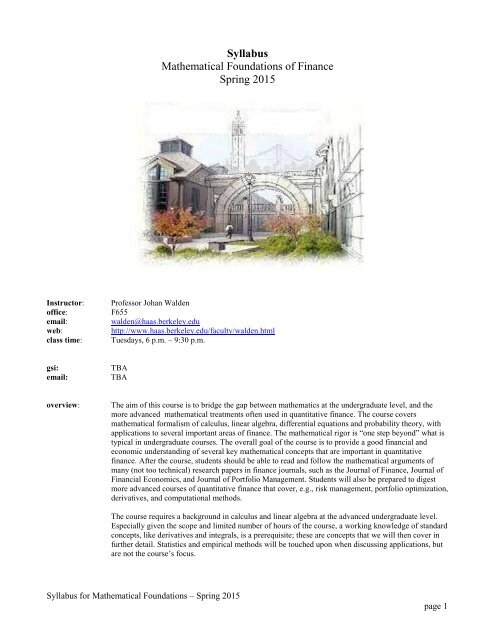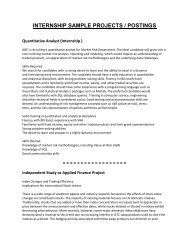Mathematical Foundations for Financial Engineering Domingo ...
Mathematical Foundations for Financial Engineering Domingo ...
Mathematical Foundations for Financial Engineering Domingo ...
Create successful ePaper yourself
Turn your PDF publications into a flip-book with our unique Google optimized e-Paper software.
Syllabus<strong>Mathematical</strong> <strong>Foundations</strong> of FinanceSpring 2015Instructor:office:email:web:class time:Professor Johan WaldenF655walden@haas.berkeley.eduhttp://www.haas.berkeley.edu/faculty/walden.htmlTuesdays, 6 p.m. – 9:30 p.m.gsi:email:TBATBAoverview:The aim of this course is to bridge the gap between mathematics at the undergraduate level, and themore advanced mathematical treatments often used in quantitative finance. The course coversmathematical <strong>for</strong>malism of calculus, linear algebra, differential equations and probability theory, withapplications to several important areas of finance. The mathematical rigor is “one step beyond” what istypical in undergraduate courses. The overall goal of the course is to provide a good financial andeconomic understanding of several key mathematical concepts that are important in quantitativefinance. After the course, students should be able to read and follow the mathematical arguments ofmany (not too technical) research papers in finance journals, such as the Journal of Finance, Journal of<strong>Financial</strong> Economics, and Journal of Portfolio Management. Students will also be prepared to digestmore advanced courses of quantitative finance that cover, e.g., risk management, portfolio optimization,derivatives, and computational methods.The course requires a background in calculus and linear algebra at the advanced undergraduate level.Especially given the scope and limited number of hours of the course, a working knowledge of standardconcepts, like derivatives and integrals, is a prerequisite; these are concepts that we will then cover infurther detail. Statistics and empirical methods will be touched upon when discussing applications, butare not the course’s focus.Syllabus <strong>for</strong> <strong>Mathematical</strong> <strong>Foundations</strong> – Spring 2015page 1
Reference texts:Rudin W., Principles of <strong>Mathematical</strong> Analysis, 3 rd Edition, McGraw Hill.Golub G.H. and Van Loan C.F., Matrix Computations, 4 th Edition, Johns HopkinsSimmons G.F. and Robertson J.S., Differential Equations with Applications and Historical Notes, 2 ndEdition, McGraw Hill.These are all excellent text books, which I recommend. Building a library of good reference books is oneof the wisest investments a student can make! However, the books are listed in order of priority <strong>for</strong> thiscourse: The material in Rudin will be most extensively covered; we will use some parts of Golub and VanLoan, and will spend less than a lecture on the material covered by Simmons. The fairly comprehensivecourse slides (together with the Internet) may even be sufficient, although this is not a recommendedapproach.The material (assignments, slides, source code, solutions, and all other material) in the course isproprietary. Posting of material on the web is strictly prohibited and will lead to legal action.In addition to the a<strong>for</strong>ementioned references, we will discuss several classical and more recent publishedpapers, to see how the mathematical concepts in the course relate to finance and economics. These papersare available on Study.Net:1. Pratt J.W. Risk aversion in the small and in the large, Econometrica, 32, 1964, 122-136.2. Litterman R. and Scheinkman J., Common factors affecting bond returns, Journal of FixedIncome, 1991, 55-61.3. Ross S. The recovery theorem, Journal of Finance, <strong>for</strong>thcoming.4. Markowitz H., Portfolio selection, Journal of Finance, 7(1), 1952, 77-91.5. Samuelson P.A., General proof that diversification pays, Journal of <strong>Financial</strong> and QuantitativeAnalysis, 2(1), 1967, 1-13.6. Nash J., Non-cooperative games, Annals of Mathematics, 54, 1951, 286-295.7. Spiegel M. and Subrahmanyam A., On intraday risk premia, Journal of Finance, 50(1), 1995,319-339.8. Cox J.C., Ross S., and Rubinstein M., Option pricing: a simplified approach, Journal of<strong>Financial</strong> Economics, 7, 1979, 229-263.homepage:assignments:We will use bCourses and Study.NetThere are eight mandatory assignments, which usually cover exercises related to finance, although theirfocus is mathematical You are encouraged to solve and hand in assignments individually, since this hasproven to lead to the most thorough learnings experience. However, you are allowed to work in a teamof two students (no more than two!), should you wish to. If you choose to work in a team, you mustprovide this in<strong>for</strong>mation on the front page of your assignment. Otherwise you will receive no credit.Assignments should be submitted electronically, and on time, via bCourses. Detailed instructions areprovided on the front page of each assignment.Students are allowed to consult all the material provided in the course (lecture notes, text books,etc.), as well as the Internet, but are not allowed to use any material that – even remotely –resembles a “solution” to the assignment. If there is any doubt, please contact the instructor. Also,students are allowed, and encouraged, to discuss the material and assignments, e.g., in thebCourses chat room. However, assignments should be solved individually (or in a teams of two,see above), and the provision of solutions or detailed tips to another student is strictly prohibited.We have a strict policy on submission deadlines. Assignments received up to 24 hours late will geta deduction of 50% of the points. Assignments received more than 24 hours late get a 100% pointdeduction.Syllabus <strong>for</strong> <strong>Mathematical</strong> <strong>Foundations</strong> – Spring 2015page 2
The following concepts will be covered in the assignments:1. Sets, number systems and functions2. Sequences & series, continuity and differentiation3. Linear algebra and matrices4. Eigenvectors and spectral theory5. Integration6. Multidimensional calculus & optimization7. ODEs and PDEs8. Probability theory and stochastic calculusgrades:exam:gsi sessions:The grades are Pass/No Pass. Students who complete the assignments satisfactorily and on time willreceive a certificate that they have passed the course. All other students will not receive such acertificate. There is thus no “fail grade” in the course. Students who decide to “audit” the coursethere<strong>for</strong>e do not need to take any <strong>for</strong>mal action, but are encouraged to send an e-mail to in<strong>for</strong>m theprofessor about their decision.There is no exam.There will be no <strong>for</strong>mal GSI sessions. Students should contact the GSI via email or through thebCourses chat <strong>for</strong>um with their questions.Syllabus <strong>for</strong> <strong>Mathematical</strong> <strong>Foundations</strong> – Spring 2015page 3
lecture plan:For simplicity, topics and readings are presented as full lectures. Some topics may run over tothe next lecture. Consequently, we may fall behind the listed schedule a bit at some points andthen catch up soon thereafter.January 20 topic: Sets, number systems, functions, and metric spaces. Lecture 1Rudin, ch. 1-2January 27 Due: Assignment 1topic: Sequences and series, continuity, limits, differentiation Lecture 2Taylor seriesRudin, ch 3-5Pratt (1964)Fabruary 4(!) Due: Assignment 2topic: linear spaces and matrix algebra, eigenvaluesLecture 3Litterman and Scheinkman (1991)February 10 Due: Assignment 3topic: Eigenvalues, spectral theory, stochastic matrices Lecture 4Ross (2014)February 17 Due: Assignment 4topic: Integration, multidimensional calculus Lecture 5Rudin, ch 6, 9February 24 Due: Assignment 5topic: Multidimensional calculus continued, optimization Lecture 6Rudin, ch 9Markowitz (1952)Nash (1952)Samuelson (1967)March 3 Due: Assignment 6topic: ODEs and PDEs Lecture 7SimmonsSpiegel and Subrahmanuyam (1995)March 10(?) Due: Assignment 7topic: Probability theory and stochastic calculus Lecture 8Cox, Ross, Rubinstein (1979)March 17, 2015 Due: Assignment 8Syllabus <strong>for</strong> <strong>Mathematical</strong> <strong>Foundations</strong> – Spring 2015page 4











